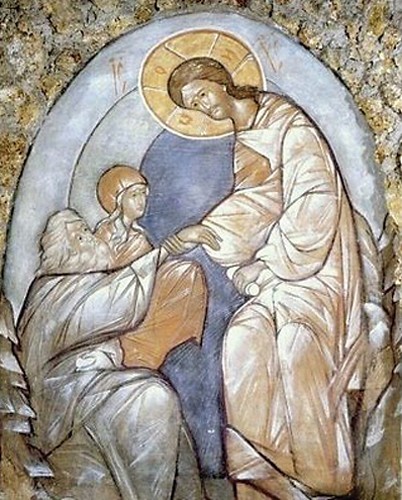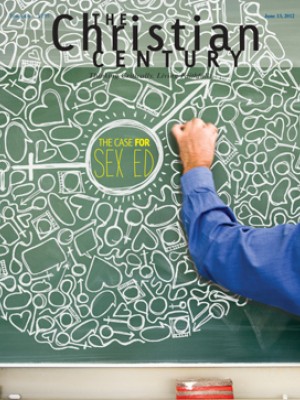Meeting Adam

It must be because it’s the last thing I see every night before I go to sleep—a photograph by the Very Rev. Andrew Tregubov of the Anastasis (or “Descent into Hades”) icon fresco by 20th-century Russian iconographer Gregory Kroug. It must be the sight of Adam’s face looking up at Christ’s, and Christ’s face looking down at Adam, that gave me the dream I had a few weeks ago.
I dreamed of meeting Adam in heaven. He wasn’t hard to recognize. In fact, he looked like my great-uncle Harold—“Bubby,” as great-aunt Sally called him—with the weight of his long years melted off. This was indeed a surprise. “Uncle Harold? Is it really you?” I said. He seemed to say yes, but no further revelation was given, and soon I was dreaming about a shortage of guest towels in the linen closet.
Read our latest issue or browse back issues.
Of course, if this had been a real glimpse of Adam, I might have expected to see other relatives, too, including some I never met in life, not to mention the entire race of redeemed men and women. That, at least, is what the mystical traditions about Adam would have us think: he is Adam Kadmon, Adam Protoplast, the representative of all humanity, first creature to bear the divine image and likeness, namer of the animals, revered by the unfallen angels, a glorious being whose rebellion was a universal catastrophe and whose redemption is the universal hope. To meet Adam face to face would be a low-grade beatific vision: one would see straight through to the essence of humanity; one would see all the generations in him and discover one’s own true self.
There’s plenty of esoteric speculation along these lines in the Apocrypha and Pseudepigrapha, and in various writings of Jewish and Christian Platonists, Kabbalists, Sufis, Ismaili philosophers, Mormons, Druze—some of it outlandishly mythological, some of it (where Eve comes in) misogynist. It’s not difficult to see why these legends didn’t make it into the canon. Nonetheless, there is something enchanting about reading in the rabbinic accounts that Adam was as vast as our planet, or in the Syriac Cave of Treasures that his body sparkled like crystal, or in Philo that there were two Adams, one heavenly and one earthly, or in the Life of Adam and Eve that Eve and Seth made a last-ditch effort, after the fall, to cure Adam’s mortal illness with oil from the Tree of Life.
Perhaps I’ve spent too long looking at the Anastasis icon to be satisfied with abstract theological anthropology. As Coleridge said, citing Augustine, “Why not both? Why not at once symbol and history?”
Why not at once symbol and history? When my son John was around 14, he propounded a version of theistic evolutionism that has always appealed to me: that the fall of man, in the biblical sense, has something to do with the descent of man in the Darwinian sense. A primordial no to the Creator spoken by our proto-parents, in a time before geologic time, introduced sin into the moral world and death into the natural world, following which the human race would have to descend by means of mutation and natural selection, fatally diminished yet retaining the dim memory of our proto-parents’ original justice and friendship with God. Weakened by this double descent, implicated in the whole sorry history of the human race, we are truly children of Adam and Eve even though we cannot reconstruct the family tree.
Some Christians prefer to think of Adam as an archetypal symbol, comparable to the Vedic Purusha or the Gnostic Anthropos, the mythic cosmic man. If so, it is Christ rather than Adam who reveals to us what it means to be a human being. Jesus Christ is the first and only creditably historical person (“present at scenes a little subsequent to the supper-parties of Horace,” as G. K. Chesterton puts it) of whom billions of men and women have been moved to say “in him we live and move and have our being.” In Kroug’s Anastasis, it is this historic man Jesus Christ who seizes Adam by the wrist and lifts him from death to life, as if to say, in the words of the patristic homily: “I order you, O sleeper, to awake. I did not create you to be held a prisoner in hell. Rise from the dead, for I am the life of the dead. Rise up, work of my hands, you who were created in my image. Rise, let us leave this place, for you are in me and I in you; together we form one person and cannot be separated.”
The second Adam preexists the first: Christ precedes creation and the promise of redemption precedes the fall; yet it is the cosmic Christ who has the more secure claim on historical reality. It is Jesus Christ in whom Uncle Harold (“Bubby”) lives, wholly himself, drawn out of the abyss. Our life in Adam may be a passing dream, but whatever else “in Christ” means, it cannot be merely a symbol.





